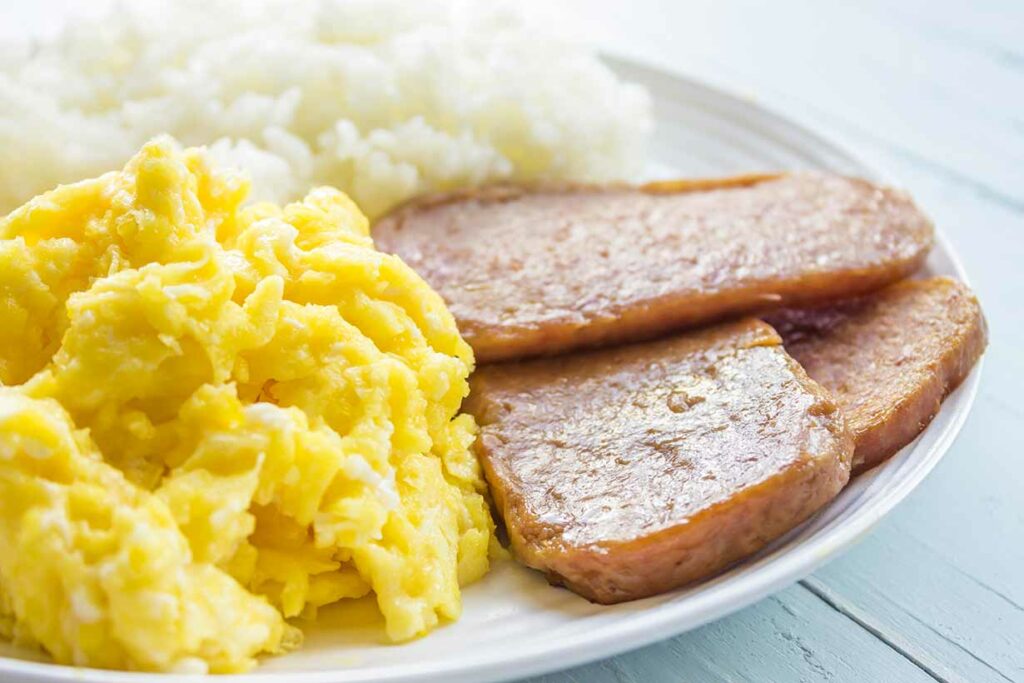Some people love the taste of spam.
On the other hand, many think of it as an ultra-processed meat product with questionable nutritional value.
Is spam really bad for you? Does it have any beneficial properties? And just what is it?
This article provides a complete guide to spam.
Table of contents
What Is Spam?

Spam is a brand of canned pork that is popular around the world. Also, it is perhaps the most popular brand of processed meat.
A company called Hormel Foods launched spam in the year 1937, shortly before the start of World War 2.
Although the story behind the name ‘spam’ is a bit of a secret, the brother of a vice president at Hormel Foods called Ken Daigneau named it (1).
During World War 2 and the years following the war, spam became an important food product for soldiers. Additionally, due to spam’s shelf life and ease of transportation, it became a standard export for countries needing food aid (2).
A later example came with the integration of spam into South Korean cuisine. This integration happened after soldiers introduced it to the local population during the Korean war (3).
At present, spam is a staple food in Korea. In 2019, it hit a sales record by selling the equivalent of 24 cans for every person in Korea over the year (4).
According to the official spam website (5):
- Spam is available in 44 different countries
- Worldwide, people eat 12.8 cans of spam every second
- More than 9 billion cans of spam have been sold since its introduction
What Ingredients Does Spam Contain?
Spam is made from what the company that makes it refers to as ‘six simple ingredients’, and these include (5):
- Pork with ham: the pork is mostly from pork shoulder
- Salt
- Water
- Potato starch: a binding agent to hold the pork together
- Sugar
- Sodium nitrite: a preservative that helps to prevent bacterial growth, preserves the red/pink color of the meat, and enhances the flavor
The ingredients label lists the pork content of spam as 89%, and the other five ingredients make up the remaining 11%.
Nutritional Values
Based on USDA data, here are the nutritional values for spam per 3.5 oz (100-gram) serving (6). Daily values have been calculated using USDA data and the FDA’s recommended daily values (7).
| Name | Amount | % Daily Value (% DV) |
|---|---|---|
| Calories | 315 kcal | |
| Fat | 26.6 g | 34.1% DV |
| Saturated | 9.99 g | 50.0% DV |
| Monounsaturated | 13.5 g | |
| Polyunsaturated | 2.02 g | |
| Omega-3 | 0.08 g | |
| Omega-6 | 1.89 g | |
| Cholesterol | 71 mg | |
| Sodium | 1410 mg | 61.3% DV |
| Carbohydrate | 4.6 g | 1.7% DV |
| Fiber | 0 g | 0% DV |
| Sugars | 0 g | |
| Protein | 13.4 g | 26.8% DV |
Vitamins
- Thiamin: 26.7% of the daily value (DV)
- Niacin (B3): 22.1% DV
- Vitamin B12: 18.8% DV
- Riboflavin (B2): 13.8% DV
- Vitamin B6: 12.9% DV
- Choline: 12.5% DV
- Vitamin D: 3% DV
- Vitamin E: 2.8% DV
- Folate, DFE: 0.8% DV
Minerals
- Sodium: 61.3% DV
- Selenium: 41.6% DV
- Zinc: 14.5% DV
- Phosphorus: 12% DV
- Potassium: 8.7% DV
- Iron: 8% DV
- Copper: 5.6% DV
- Magnesium: 3.3% DV
Benefits
Here are some of the beneficial properties of spam.
It offers a Broad Range of Vitamins and Minerals
Spam sometimes gets a bad name because it is a form of processed meat.
However, as seen in the nutritional values section, it is a good source of several vitamins and minerals.
Among these nutrients, spam contains more than 10% of the daily value for B vitamins, choline, sodium, selenium, zinc, and phosphorus per 3.5 oz (g) serving (6, 7).
Since spam is approximately 90% pork by weight, it shares a similar nutritional profile and much of the same nutritional benefits.
Long Shelf Life
Another benefit of spam is that it has a long shelf life and can be stored and transported easily.
As previously mentioned, the best example is the use of spam by soldiers during World War 2.
All cans of spam have been pre-cooked, making it a food that is easy to store and prepare. Therefore, this removes worries about quickly using it within a short timeframe like fresh meat.
These are properties that may appeal to some people.
Downsides
As a type of processed meat, there are some concerns about spam that don’t apply to fresh, unprocessed meat.
Here are some of the potential downsides.
Very High In Sodium
Spam contains a significant amount of salt, thus providing 1410 mg of sodium per 100 grams (6).
The recommended daily value for salt is 2300 mg (7). Additionally, the Dietary Guidelines for Americans 2020-2025 recommended that people consume less than 2,300 mg of sodium daily (8).
In other words, 100 grams of spam contain 61% of the recommended daily sodium limit.
Diets with excessively high salt intake are strongly associated with higher blood pressure and increased cardiovascular risk (9, 10).
On this note, a dose-response meta-analysis of 85 sodium reduction studies examined the blood pressure effects of this sodium reduction (11).
Notably, the researchers demonstrated a linear relationship between sodium reduction and lower systolic and diastolic blood pressure.
The higher the level of sodium reduction, the more blood pressure fell in the participants.
This relationship existed “across the entire range of dietary sodium exposure” (11).
Contains Sodium Nitrite
Alongside other types of processed meat like bacon and some cured meats, spam contains sodium nitrite.
Sodium nitrite is a type of preservative that has several valuable functions as a food ingredient (12):
- It preserves the pink/red color of meat
- Enhances the flavor
- It helps to prevent bacterial spoilage and the growth of bacteria in general
Nitrates and nitrites are a natural component of many vegetables, and we can also find them in drinking water (13).
However, nitrite can react with amino acids (proteins) during high-heat cooking to form nitrosamines. Furthermore, nitrosamines can also form in acidic environments like the stomach (14).
Nitrosamines have been found to be carcinogenic (15).
Thus, it is widely thought that a diet rich in nitrite/processed meats can increase cancer risk through greater exposure to nitrosamines.
Large observational studies appear to support this, with several studies finding associations between higher processed meat intake and cancers of the digestive system, amongst others (18, 19, 20).
How Big is the Risk From Processed Meat?
Firstly, it is important to note that these studies show very little increase in risk in the lowest consumption categories (i.e. <1.5 servings per week).
Furthermore, the findings suggest the risk is more significant at the highest intake levels, with multiple weekly servings.
Despite this, the World Cancer Research Fund (WCRF) recommends “eat little, if any, processed meat” (21).
The Dietary Guidelines for Americans, 2020-2025 advise that “most intake of meats and poultry should be from fresh, frozen, or canned, and in lean forms (e.g. chicken breast or ground turkey) versus processed meats” (22).
The United Kingdom’s National Health Service (NHS) doesn’t differentiate between red meat and processed meat. However, the NHS recommends that “if you currently eat more than 90g (cooked weight) of red or processed meat a day, the Department of Health and Social Care advises that you cut down to 70g” (23).
As shown, there is a consensus among major health organizations that processed meat intake should be limited.
This guidance does not mean that we shouldn’t ever consume processed meat, and small amounts are unlikely to be a big issue. However, as demonstrated, higher intakes are associated with detrimental health outcomes.
Lower in Protein and Higher in Fat Than Most Meat
Another important point about spam is that it has approximately twice the fat content as protein.
For example, 100 grams of cooked chicken breast provides 28 grams of protein (24).
Cooked pork shoulder (lean and fat eaten) offers 23.1 grams of protein per 100 grams (25).
With 26.6 grams of fat and only 13.4 grams of protein per 100 grams, spam does not offer the same protein characteristics as most fresh meat (6).
Note: see this article for the leanest meat options.
Additionally, spam contains approximately 10 grams of saturated fat per 100 grams (about 90 calories from saturated fat).
The Dietary Guidelines for Americans recommends keeping saturated fat intake below 10% of total calories (22). This would be about 22 grams of saturated fat (200 calories) based on a 2000-calorie diet.
Types of Spam
While there was initially only one variety of spam, numerous variations are now available.
According to the spam website, here are the different spam product varieties available at retail:
- ‘Classic’
- ‘Lite’ (50% less fat)
- ‘25% Less Sodium’
- ‘Spam with Bacon’
- ‘Oven Roasted Turkey’
- ‘Hickory Smoke’
- ‘Hot and Spicy’
- ‘Jalapeno’
- ‘Teriyaki’
- ‘Spam with Portuguese Sausage Seasoning’
- ‘Spam with Tocino seasoning’
- ‘Single Classic’ (single-serve)
- ‘Single Lite’ (single-serve with 50% less fat, 25% less sodium)
- ‘Spam Classic 7 oz’ (smaller 7 ounce/198g can)
Based on this, there are fourteen varieties of spam available at retail.
How To Use Spam
There are many ways to use spam, some of which may seem quite surprising.
For instance, in Japan, ‘spam musubi’ is a popular sushi-like (just replace the fish with spam) combination of seasoned spam and rice.
Korean ‘army stew‘ is a fusion dish of Korean-style ingredients like noodles, mushrooms, tofu, and kimchi alongside spam in a spicy sauce.
Then there are the more typical options, such as spam fritters and sandwiches.
The spam website also provides a broad range of recipes, from easy-to-make snacks to internationally inspired ideas.
Final Thoughts: Is Spam “Bad” For You?
Spam is popular in many countries and offers a taste many people enjoy.
However, some people who enjoy spam may also worry after hearing claims of it being “bad for you.”
Is there a reason to worry?
Firstly, the consensus from current research is quite evident in that we should limit our processed meat intake. As a result, spam isn’t a food that should play a prominent role in our diets.
However, this does not mean that we cannot include it in our diet from time to time. For instance, the absolute risks from consuming low amounts of processed meat are relatively small and not significantly different from non-consumption.
A serving or two each week probably isn’t worth too much worry, but higher intakes are associated with an increased risk of detrimental outcomes, according to the current evidence.
Lastly, protein options such as unprocessed meat, poultry, seafood, legumes, and tofu offer more nutritional benefits for fewer downsides.








